As we move further into the digital era, it becomes clear that interaction-driven experiences are here to stay. In the 21st century, hyper-personalisation and interaction have transformed the way we think about and choose products and services. Modern consumers don’t just want to buy things, they also want authentic experiences that capture their interest, add value, and speak to them at personal level. In this post we take a look at some of the best experiential marketing examples, and at what you can learn from them.
What is experiential marketing?
Before we look at our selected experiential marketing examples, we need to clarify what is experiential marketing. This is a set of powerful strategies that are usually planned around events. The important thing to note is that experiential marketing redefines the concept of event: events aren’t only corporate affairs like conferences or trade fairs, but any chance of interaction between consumers and a brand, such as wayfinding at a museum or shopping centre, attending an appointment with healthcare service provider, etc.
In experiential marketing, the focus shifts from products and services to experiences that draw the audience in and make them an integral part of the brand and its identity. This works because it’s able to create genuine engagement, immersing audiences into a delightful journey of discovery they can be part of.
For businesses, one of the main benefits of experiential marketing is its inherent ability to generate loyalty and create a positive brand impression. A recent study shows that experiential marketing strategies are more effective than digital advertising, content marketing, or traditional advertising, and that almost 95 per cent of consumers are more likely to remember brands that deliver experiences. Let’s see how this is done in practice by looking at three experiential marketing examples.
Three of the best experiential marketing examples from across the web
Guinness Class Campaign
In 2012, Guinness supercharged its marketing efforts with a 9-week experiential marketing campaign. Company ambassadors visited pubs and bars, inviting participants to buy a pint of Guinness and shake a mobile app prize generator. The winners were rewarded with a trip to Dublin on a private jet.
What you can learn:
Even established brands need to adapt to changing expectations. Reputation and loyalty are not written in stone and being an early adopter of new marketing trends improves chances of success.
Don’t make your customers go out of their way to participate in an experiential marketing campaign. Guinness got this right by going where the audience was and making participation easy.
Sensodyne’s Great Sensitivity Test
Sensodyne put together an experiential marketing campaign in London that reached 4 million people. The campaign was designed as a journey that took participants into three different zones: Zone 1 was meant to stir people’s curiosity with a range of interactive experiences, from free dental check-ups to buzzer games. Zone 2 offered a great photo op with a giant molar in an iconic London setting, added a fun element and gave participants the opportunity to share it. Zone 3 had over 200 people take part in the world’s largest oral hygiene lesson.
What you can learn:
The idea of a “journey of discovery” (crucial in experiential marketing) is not just a metaphor. Multi-zone setups are one of the most effective ways of achieving a memorable lived-in experience.
It’s important to deliver valuable knowledge with real-life applications. In this case, participants learnt something that could help them enjoy a better quality of life.
Boost your chances of success by planning a multi-channel strategy that includes social media.
Topshop’s Splash
Retailer Topshop took its 2017 summer campaign to a new level by letting customers go on a virtual tropical journey at its flagship Oxford Street store. The combination a basic inflatable slide and virtual reality equipment made for a delightful experience that lent itself perfectly to be shared on social media. The figures speak by themselves, as swimwear sales increased by 100 percent during the campaign.
What you can learn:
Experiential marketing is not about the product itself, but about what customers want at a particular point in time.
Think forward and take advantage of new experience-focused technologies, such as virtual reality solutions, interactive kiosks, 4k video walls, etc.
The new economy is all about customisation and creative hands-on participation. If you own a business, you simply can’t afford to miss out on this trend. As you can see from the experiential marketing examples reviewed above, this is a powerful tool that can help you amplify your message and turn audiences into loyal brand ambassadors.
[divider style=’left’]
At LamasaTech we design experiential marketing solutions that fit your needs and inspire your audience. Get in touch to find out how you can take your marketing campaigns to a new level with experiential marketing.



